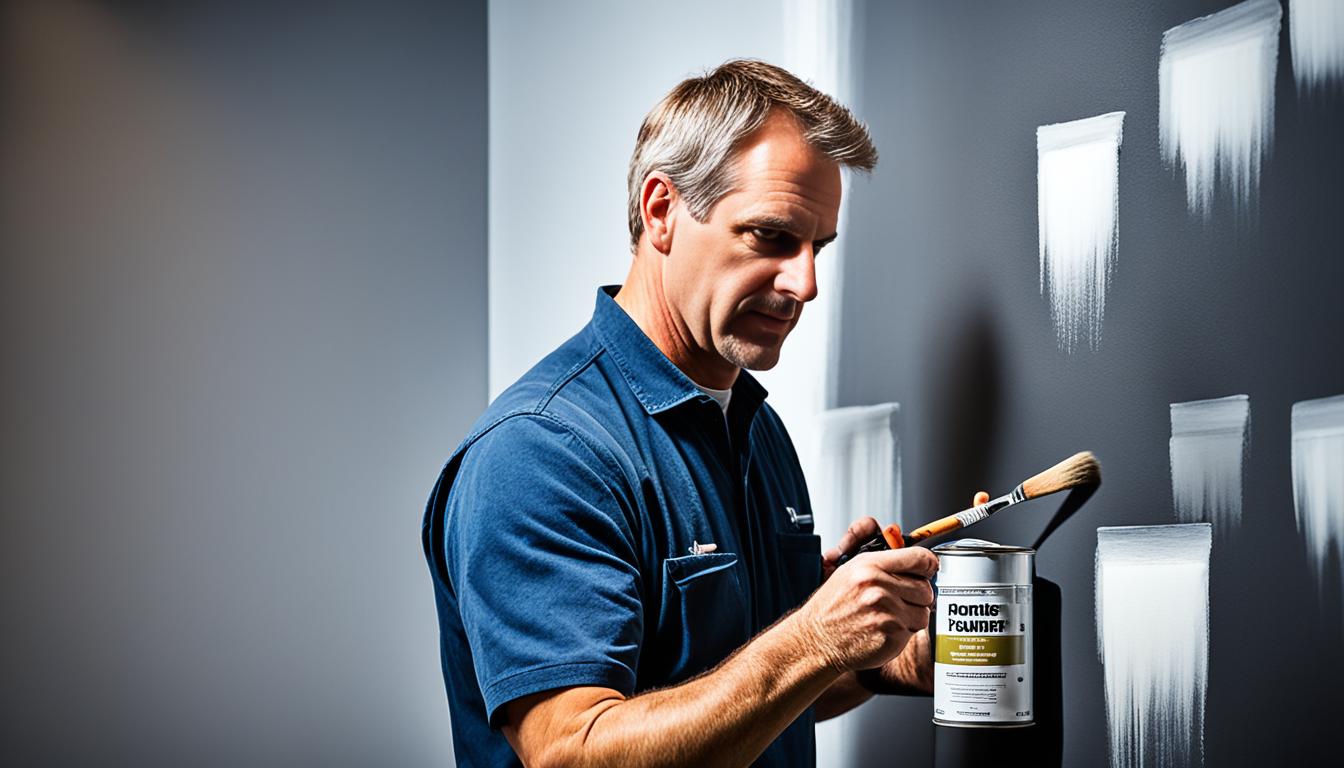Painting your room can change its feel, especially from dark to light colors. It brings new energy. Experts like Julie Fisher from Dutch Boy Paints shared this fact. They say patience, good primers, and the right tools make the finish look amazing.
Insider tips from pros like Artem Kropovinsky of Arsight and Tina Nokes from Five Star Painting of Loudoun stress the importance of quality primers. These primers cover dark colors well. They ensure your paint job looks great and lasts long.
Key Takeaways
- Interior painting over dark walls requires patience and meticulous preparation.
- High-quality primers and paints are critical for covering dark hues effectively.
- Using the appropriate tools ensures an even application and a professional finish.
- Expert advice can facilitate a smoother transition when applying light colors over dark hues.
- Patiently layering paints as recommended by painting strategies can achieve an even, vibrant finish.
The Challenge of Dark Interior Painting: Overcoming Common Hurdles
Working on interior design challenges has taught me lots. I found that painting over dark paint comes with its own problems. The most important step is getting the walls ready. This is key for moving from dark to light colors.
Julie Fisher from Dutch Boy Paints says cleaning the wall first is a must. This means no dust and having a smooth surface. Any holes need to be filled. Then, these spots should be sanded until smooth. This makes sure primer and paint stick well, leading to great coverage.
The next thing to do is pick a good primer. It’s best if the primer’s color is close to what you want in the end. This step is really helpful for covering very dark colors. A good primer hides the old color and means you’ll need fewer topcoats.
It’s also key to pay attention to how you put the paint on. The thickness of paint layers and the tools you use matter a lot. The main aim is to get a smooth finish. The right techniques make sure the new color looks good, without any dark spots showing.
Changing from a dark to a light color isn’t just about paint. It’s about changing the feel of the whole room. With good preparation and the right painting methods, this job becomes easier and fun.
Preparation is Key: Prime for Success
When starting a painting task, it’s super important to use prime over dark colors. Experts like Tina Nokes and Artem Kropovinsky share key tips. They say good painting preparation leads to a great finish.
First, I picked the right wall primer. It needed to cover my dark walls well. Tina Nokes says a tinted primer works best for this. It helps the new color pop.
Artem Kropovinsky calls the primer the ‘unrecognized hero’. It hides the old color and gives a good base. This helps when painting over dark shades.
I applied the primer carefully to avoid streaks. I paid extra attention to corners and edges. That’s where dark colors show through the most.
Choosing the right wall primer and preparing well was key. Now, my project is set to succeed. The new bright colors will shine. Proper priming is a must in home decorating.
Selecting Superior Paints for Covering Dark Hues
Painting over dark walls needs the right high-quality paints. Some paints cover better than others. To go from dark to light shades, it’s key to pick paints that cover well and last long.
Top brands like Sherwin Williams Duration, Benjamin Moore Aura, and Dutch Boy® Platinum Plus are great choices. They excel in covering dark colors with fewer coats. Sherwin Williams Duration and Benjamin Moore Aura are known for their strong finish and long life. These features are vital for painting light over dark.
Dutch Boy® Platinum Plus is especially good. It has a paint and primer in one. This makes it hide the old color well and work efficiently. This is great for those who want top quality and easy use.
| Brand | Product Type | Key Feature |
|---|---|---|
| Sherwin Williams | Duration | High durability and excellent coverage |
| Benjamin Moore | Aura | Rigorous color retention and low VOC |
| Dutch Boy® | Platinum Plus | Paint and primer in one with extreme hide |
Each product is made thinking of the user. They make painting less stressful. Whether you’re new or experienced, choosing high-quality paint is key for a pretty, lasting finish.
Layering Techniques for Flawless Coverage
Learning paint layering is key for changing shades from dark to light. One main focus is the coat application process. This process needs many layers for the best coverage. I use special painting techniques and using rollers for even looks.
The first layer is very important. I start with a strong primer. Then, I add a solid base coat of good paint. This base covers dark colors and gets the surface ready for more layers. Make sure this coat dries well before adding more.
The next layers need to be consistent. I make sure the paint on the roller is even. This avoids drips or uneven spots. It’s about making a smooth coat that looks good over time.
Tila Lee from Pretty In Paint School said, “The magic is in how you use your tools. Make each layer even and let it dry well.” I always remember her words when I do paint layering.
To show how important good coat application is, look at this table. It points out common mistakes and how to fix them:
| Mistake | Impact | Solution |
|---|---|---|
| Inconsistent Paint Application | Uneven texture and visible old hues | Use rollers for even application and maintain the same pressure |
| Insufficient Drying Time | Smudging and poor adhesion of subsequent layers | Allow each coat to fully dry before applying the next |
| Skipping Base Layer | Poor coverage and higher transparency | Always start with a solid base coat to ensure optimal opacity |
To wrap up, doing paint layering right makes a big difference. Use expert coat application and painting techniques with rollers. Every layer you add makes the finish even better.
The Finishing Touch: Sheens and Finishes
When I’m nearing the end of painting dark colors, picking the right paint sheen is key. Tina Nokes talked about using matte finishes. They cover better and hide wall imperfections. Matte’s lack of shine means old colors and flaws won’t show. This makes everything look neat.
But, a gloss finish has its ups and downs. While it looks sleek, it can show every little flaw. It can also make old colors stand out due to its reflection. This made me think about how sheens change a room’s look and feel.
Artem Kropovinsky said light and finishes change a room’s mood. So, picking gloss or matte affects both look and feel. A glossy surface can make a room brighter. But, it’s not great if walls have flaws.
- Matte finishes: Great for hiding flaws and smoothing out wall textures.
- Gloss finishes: Best for flawless spaces, as they make light bounce and add vibrancy.
I usually pick matte for dark or imperfect walls to get a clean look. It keeps the room’s charm while looking pro. It’s all about mixing paint sheen choices with style to make a space feel good and look right.
Conclusion
Starting a project to paint over dark walls is a big deal. But, it can also make your home feel new. I’ve shown you how to do it and what the pros say. This helps you go from dark to light walls. You need to get ready well, use the best stuff, and paint like a pro. Even if it seems hard, your room will look so good afterwards.
You don’t have to do this job alone. Some people may not feel brave enough to start painting. You can ask experts from SurePro Painting or Five Star Painting for help. They know a lot about painting and do great work.
Experts can help you pick the perfect color and the right primer. They make sure every layer of paint looks good. They know all about the best base and final touches. If you want your room to be lighter, SurePro Painting and Five Star Painting can help. They’ll make sure your painting job is perfect.
FAQ
How can I successfully paint over dark colored walls with lighter hues?
Start by cleaning the wall well. Then, apply a quality tinted primer for good coverage. Use multiple coats of good paint and paint evenly for the best finish.
What challenges might I face when painting over dark interior paint?
Covering dark colors fully can be tough. You also want the final color to look right. Prep the wall well and pick the right primer and paint to succeed.
Why is priming important when painting over dark colors?
Primer hides the old dark paint. It makes the new color bright. And, it helps the paint stick better. A primer close to your paint color works best.
What types of paint work best for covering dark walls?
Use top paints like Dutch Boy® Platinum Plus, Sherwin Williams Duration, or Benjamin Moore Aura. They cover well and often include a primer, perfect for dark to light changes.
How many layers of paint will I need to go from dark to light walls?
You usually start with a base layer over primer. Then add more as needed. Let each layer dry before adding another for a smooth look.
Which paint sheen should I choose to best cover dark colors?
Choose flat or matte finishes they hide well and don’t show wall flaws. Shiny finishes can make old colors or mistakes stand out. So, matte is better for a clean look.
Can I tackle painting over dark colors on my own, or should I hire professionals?
You can try it yourself with preparation and patience. But, pros like SurePro Painting or Five Star Painting make the job quicker and easier. They know how to do it right.




